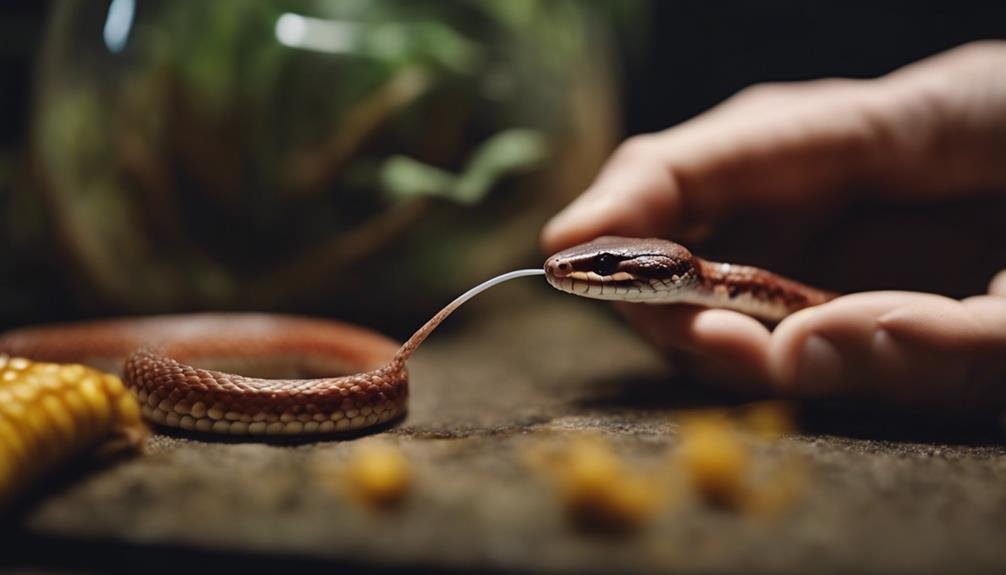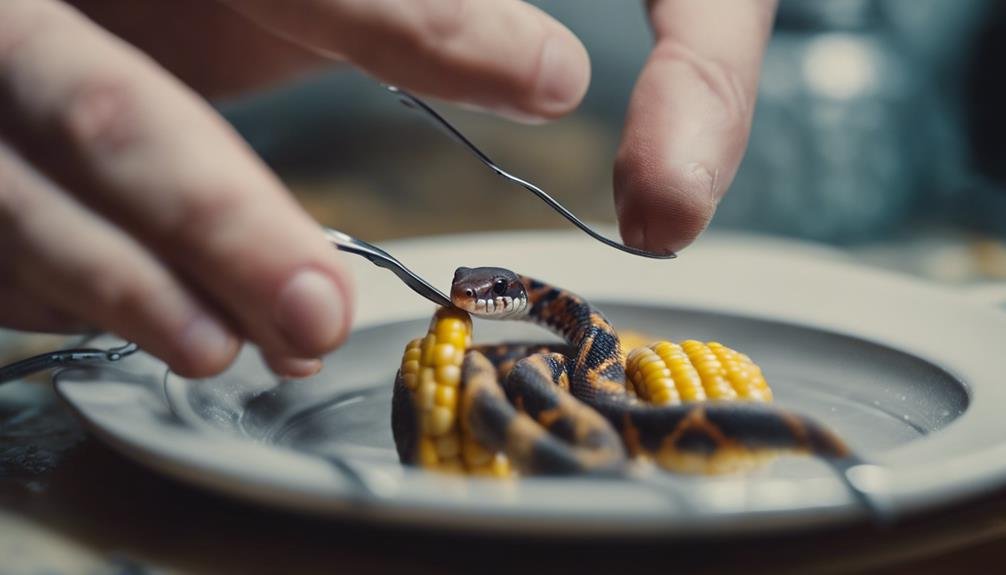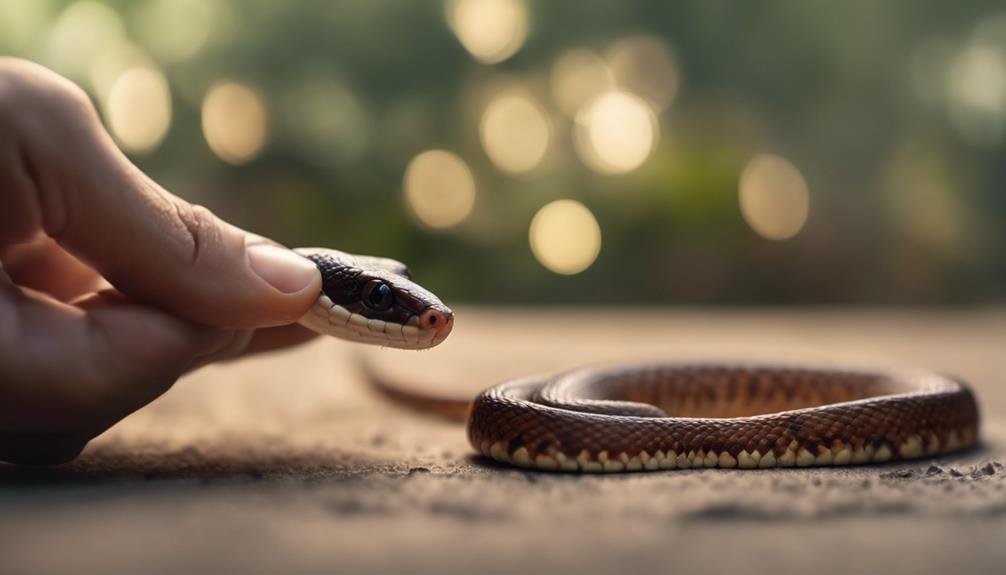When you're looking to master the art of feeding your corn snake, it's essential to start with choosing the right food that aligns with their nutritional needs. You've probably heard about using frozen mice or chicks, but the real trick lies in how you prepare and present these meals. There's a fine line between stimulating their natural hunting instincts and ensuring their safety during feeding times. If you're curious about how to navigate this delicate balance, stick around. We're about to uncover some techniques that could transform your feeding routine, making it not only more effective but also a fascinating part of your interaction with your snake.
Key Takeaways
- Select prey item sizes no bigger than 1.5 times the snake's midsection to prevent regurgitation.
- Thaw frozen rodents in warm water for 10-15 minutes before feeding.
- Use forceps or tongs to offer prey, ensuring a safe distance between your hands and the snake.
- Establish a consistent feeding schedule to support healthy growth and reduce stress on the snake.
- Monitor the snake's digestive health, adjusting the diet and seeking veterinary advice if persistent issues arise.
Choosing the Right Food
Selecting the ideal diet for your corn snake involves choosing prey items like mice, quails, or chicks that align with its nutritional needs and size. When deciding what your snake should eat, remember that mice and rats form the cornerstone of their diet, providing the essential nutrients they require. However, incorporating a variety of prey items, such as quails and chicks, can't only meet their nutritional needs but also offer some enrichment to their feeding routine.
For young corn snakes, it's important to start them off with smaller prey, like pinkies. These tiny meals are easier for them to digest and support their growth and development. As your snake grows, you'll need to adjust the size of the prey accordingly. Always make sure the prey width doesn't exceed 1.5 times the width of your snake's body to avoid any risk of regurgitation.
Before you feed your corn snake, you must defrost the prey completely. This step is essential to make sure the meal is at a safe temperature for your snake to consume. By carefully selecting and preparing a variety of prey items, you'll keep your corn snake healthy and satisfied.
Preparing the Prey
Before you feed your corn snake, it's important to choose a prey size that's no bigger than 1.5 times the snake's midsection.
You'll also need to thaw any frozen rodents in warm water for 10-15 minutes to make sure they're safe for your snake to eat.
This preparation step is vital for a successful feeding routine and the well-being of your corn snake.
Choosing Suitable Prey Size
When preparing your corn snake's meal, make sure the prey's size doesn't exceed 1.5 times the width of the snake's midsection to prevent any feeding issues. Selecting the appropriate prey size is essential for your corn snake's health and to avoid problems like regurgitation.
Here are some tips to guarantee a successful feeding:
- Choose prey that matches the size guideline to prevent regurgitation.
- Use forceps, tweezers, or tongs for safe handling and to avoid accidental bites.
- Thaw frozen prey adequately before offering it to your snake.
- Simulate movement by shaking the prey with forceps to encourage your corn snake to strike.
- Avoid handling your corn snake immediately after feeding to reduce the chance of regurgitation.
Thawing Frozen Rodents Safely
To safely prepare your corn snake's meal, always start by thawing frozen rodents in a plastic baggie submerged in warm water for about 10-15 minutes. Remember, the thawing time varies based on the size of the prey. It's important to make sure the prey is fully thawed to prevent digestive issues in your corn snake.
Once thawed, gently shake the mouse with forceps to entice your snake. This mimics live prey and can trigger your snake's hunting instinct.
| Key Step | Why It's Important |
|---|---|
| Thaw in warm water | Ensures prey is safely thawed |
| Use a plastic baggie | Keeps the rodent dry and clean |
| Fully thawed prey | Prevents digestive issues in corn snakes |
| Shaking with forceps | Entices the snake, mimicking live prey movement |
Following these steps guarantees a safe and appetizing meal for your corn snake.
Feeding Techniques


Properly feeding your corn snake involves using forceps or tongs, ensuring safety and encouraging natural feeding behavior. When it's time to feed your corn snake, there are some tricks of the trade that can make the process smoother and more effective for both you and your pet corn snake. Keeping a day-old mindset means always being prepared and understanding the best practices to feed your snake while minimizing stress and potential hazards.
Here are some key feeding techniques:
- Use forceps or tongs to offer prey to your corn snake, maintaining a safe distance of 5 inches to avoid accidental bites.
- Always thaw frozen prey thoroughly before feeding, ensuring it's warm to the touch but not hot to prevent any chance of burns.
- Consider using a separate feeding tub to reduce stress and maintain your snake's territorial comfort, though offering prey within its vivarium is also an option.
- Avoid handling your snake immediately after feeding to allow for proper digestion and to prevent regurgitation.
- Monitor your snake's feeding response closely and be ready to adjust your methods based on its behavior and preferences, ensuring successful feeding sessions every time.
Monitoring Digestive Health
Monitoring your corn snake's digestive health is vital, as regular bowel movements and the absence of regurgitation are key indicators of a healthy system. To guarantee your pet's well-being, keep an eye on its day-to-day habits. Changes in appetite or eating habits can signal underlying issues, so it's important to observe any deviations from its normal behavior.
Proper hydration plays a significant role in your snake's digestion. Make sure fresh water is available at all times, supporting efficient digestion and preventing potential problems. The temperature of your pet's environment also impacts its digestive health. A well-regulated habitat helps in the proper digestion of the snake's food, so monitor the enclosure's temperature closely.
If you notice signs of regurgitation, such as undigested food or a foul odor, this could indicate that something isn't right. The size and weight of the snake's food should be appropriate for your corn snake to manage easily. In cases of persistent digestive issues or unusual behaviors, don't hesitate to consult a vet for professional snake care advice. Keeping tabs on these aspects will help you feed a corn snake correctly and maintain its health.
Addressing Feeding Challenges


Even though you might meticulously follow feeding guidelines, your corn snake could still face challenges that prevent it from eating well. Addressing these feeding challenges is important, especially for baby snakes that are still growing. Baby snakes need to reach a certain size and weigh around 5-9g in weight to make sure they're developing properly.
To navigate through these challenges, consider:
- Adjusting feeding frequency based on the snake's age and size. Younger snakes might require more frequent meals than adults.
- Monitoring weight regularly to make sure your corn snake is gaining weight and are fully benefiting from their diet. If they're not, it's time to reassess your feeding strategies.
- Offering a variety of prey items to appeal to picky eaters and stimulate their appetite.
- Creating a comfortable feeding environment with proper temperatures and minimal disturbances to encourage eating.
- Seeking guidance from experienced individuals or a veterinarian if challenges persist, ensuring you're not overlooking a potential health issue.
Enhancing the Feeding Experience
To enhance your corn snake's overall well-being, consider using a feeding tub to minimize stress during meal times. This separate environment not only improves the feeding experience but also helps in reducing the anxiety associated with live prey. Establishing a consistent feeding routine further secures your snake's comfort and predictability around mealtimes.
It's vital for your corn snake to not just eat, but to thrive and exhibit natural feeding behavior, which can be encouraged by offering a variety of prey items. Including rats, mice, chicks, hamsters, and guinea pigs in their diet enriches their nutritional intake and keeps them engaged.
Monitoring your corn snake's feeding behavior is essential to adjust the prey size, ensuring it's appropriate to prevent regurgitation and promote proper digestion. It's also important to avoid handling your corn snake right after feeding to allow for undisturbed digestion and minimize the risk of regurgitation. By following these guidelines, creating a consistent feeding schedule, and varying the diet, you'll encourage healthy, natural feeding habits that contribute to your corn snake's longevity and happiness. Remember, a happy snake is a healthy snake.
What Should I Do If My Corn Snake Hasn’t Eaten and Could Potentially Be Lost?
If your corn snake hasn’t eaten and could potentially be lost, it’s important to act quickly. Use these tips for finding lost corn snake: thoroughly search the immediate area, check warm and dark places, and place hides or water bowls around the house to entice the snake out.
Conclusion
To conclude, feeding your corn snake properly requires a bit of know-how and attention to detail. By choosing the right food, preparing prey correctly, and employing effective feeding techniques, you're on your way to ensuring your snake's health and happiness.
Don't forget to monitor its digestion and be ready to tackle any feeding challenges that come up. Enhancing the feeding experience by mimicking natural behaviors can also make mealtime more enriching for your snake.
Happy feeding!


